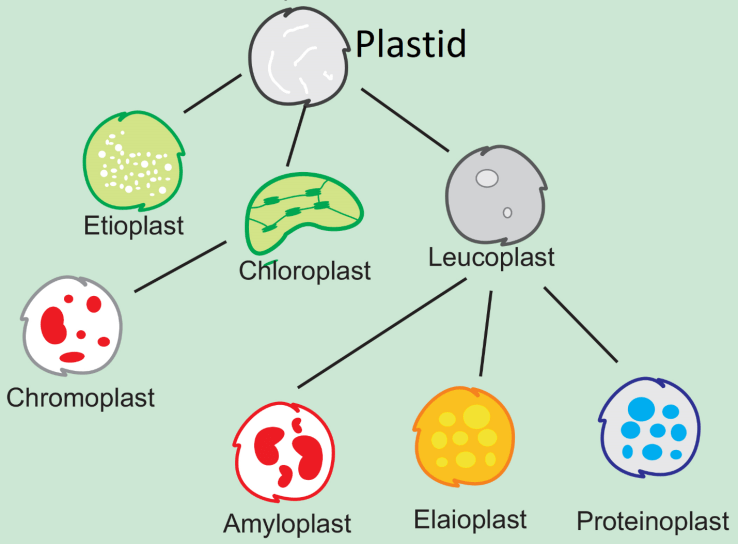
Answer
380.7k+ views
Hint: In all plant cells and in euglenoids, plastids can be found. Plastids are small yet easily observable under microscope. These are double membrane organelles. They are majorly responsible for manufacturing and storing of food. They bear some specific or certain kind of pigments used in photosynthesis which impart specific colors to the plants or plant cells.
Complete Explanation:
As we discussed above plastids are present only in plants and some lower eukaryotic organisms. So, they are absent in animal cells and higher eukaryotic cells.
Plastids may be divided into chloroplasts, chromoplast and leucoplasts on the basis of the type of pigments.

The chloroplasts contain chlorophyll and carotenoid pigments that are essential for photosynthesis and trapping light energy. In chromoplasts fat soluble carotenoid pigments like carotene, xanthophylls and others are present, this gives the plant parts a yellow, orange or red color. Then the last pigment leucoplasts- as the name suggests leucoma means colorless hence, they are colorless plastids of various shapes and sizes with stored nutrients. Amyloplasts store carbohydrates (starch) like- potato. Etioplasts store oils and fats whereas the leucoplasts store proteins.
Plastids are considered to be intracellular endosymbiotic cyanobacteria. They were discovered and named by Ernst Haeckel. They are also sites for storage and manufacture of chemical compounds of cells like-autotrophic eukaryotes. They have a circular double-stranded DNA molecule.
All plastids come from proplastids present in the plant's meristematic areas. Proplastids are usually separated by binary fission, a mode of asexual reproduction. Plastids have the capacity to differentiate or redifferentiate depending on their morphology and function.
Each plastid creates several copies of a circular plastome of \[10 - 250\] kilobases. Plastid DNA exists as large protein DNA complexes associated with the inner envelope membrane and called plastid nucleoids. Each nucleoid particle may contain more than the \[10\] copies of the plastid DNA.
Note:
Plastids are thought to know that endosymbiotic cyanobacteria. Archaeplastida's main endosymbiosis is assumed to occur approximately \[1.5\] billion years ago and has allowed eukaryotes to perform oxygenic photosynthesis. Hence plastids are important for plant cells as they impart colors to plants.
Complete Explanation:
As we discussed above plastids are present only in plants and some lower eukaryotic organisms. So, they are absent in animal cells and higher eukaryotic cells.
Plastids may be divided into chloroplasts, chromoplast and leucoplasts on the basis of the type of pigments.

The chloroplasts contain chlorophyll and carotenoid pigments that are essential for photosynthesis and trapping light energy. In chromoplasts fat soluble carotenoid pigments like carotene, xanthophylls and others are present, this gives the plant parts a yellow, orange or red color. Then the last pigment leucoplasts- as the name suggests leucoma means colorless hence, they are colorless plastids of various shapes and sizes with stored nutrients. Amyloplasts store carbohydrates (starch) like- potato. Etioplasts store oils and fats whereas the leucoplasts store proteins.
Plastids are considered to be intracellular endosymbiotic cyanobacteria. They were discovered and named by Ernst Haeckel. They are also sites for storage and manufacture of chemical compounds of cells like-autotrophic eukaryotes. They have a circular double-stranded DNA molecule.
All plastids come from proplastids present in the plant's meristematic areas. Proplastids are usually separated by binary fission, a mode of asexual reproduction. Plastids have the capacity to differentiate or redifferentiate depending on their morphology and function.
Each plastid creates several copies of a circular plastome of \[10 - 250\] kilobases. Plastid DNA exists as large protein DNA complexes associated with the inner envelope membrane and called plastid nucleoids. Each nucleoid particle may contain more than the \[10\] copies of the plastid DNA.
Note:
Plastids are thought to know that endosymbiotic cyanobacteria. Archaeplastida's main endosymbiosis is assumed to occur approximately \[1.5\] billion years ago and has allowed eukaryotes to perform oxygenic photosynthesis. Hence plastids are important for plant cells as they impart colors to plants.
Recently Updated Pages
Identify the feminine gender noun from the given sentence class 10 english CBSE

Your club organized a blood donation camp in your city class 10 english CBSE

Choose the correct meaning of the idiomphrase from class 10 english CBSE

Identify the neuter gender noun from the given sentence class 10 english CBSE

Choose the word which best expresses the meaning of class 10 english CBSE

Choose the word which is closest to the opposite in class 10 english CBSE

Trending doubts
Sound waves travel faster in air than in water True class 12 physics CBSE

A rainbow has circular shape because A The earth is class 11 physics CBSE

Which are the Top 10 Largest Countries of the World?

Fill the blanks with the suitable prepositions 1 The class 9 english CBSE

One Metric ton is equal to kg A 10000 B 1000 C 100 class 11 physics CBSE

How do you graph the function fx 4x class 9 maths CBSE

The Equation xxx + 2 is Satisfied when x is Equal to Class 10 Maths

Give 10 examples for herbs , shrubs , climbers , creepers

Change the following sentences into negative and interrogative class 10 english CBSE




